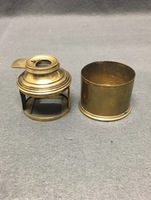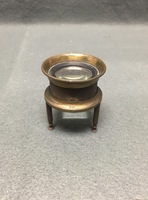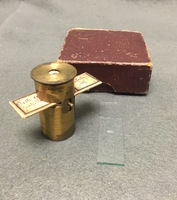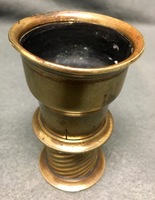Items
Tag
Brass
-

Brass and Wood Telescope
The small Victorian 2-draw pocket telescope is made from brass and mahogany. The telescope has its original patina. The telescope focuses via a sliding mechanism of the body-tube through the draw-tube. -

Brass Telescope
The miniature telescope comes with the original, cylinder wooden case. The telescope focuses via a sliding mechanism and is made from brass. The draw-tube has diagonal dash markings which seem to be handmade. -

Pocket Microscope
The simple pocket microscope is made from brass and is similar to a "squat" model. The ocular lens has a cover to protect the lens which slides out a slot compartment. The lower section of the instrument has two pillars and a square cut out in the bottom in which a specimen can be inserted for observation. The microscope comes with a fitted cylinder case. -

Desktop Magnifier
The circular desktop magnifier can be adjusted via a thumbscrew thread which works as the coarse focusing. The magnifier is made from brass and contains two lenses. The instrument has three legs that seem to date it in the 1840s due to the popularity of the design. The instrument would be used to assist those with failing eyesight to read or observe photographs. -

Bullseye Condenser
The bullseye condenser is made from brass and has a plano-convex lens. The instrument has a circular base which is weighted and a thumbscrew-style end on the arm to help maneuver the condenser lens. The instrument would have been used to direct light onto a specimen for observation from a candle or lamp. The words "BROADHURST CLARKSON & Co, 63 FARRINGDON ROAD LONDON E. C." are etched into the base. -

Handheld Brass Microscope
The simple microscope is made from brass. The microscope magnifies items 50 times linearly. The design is also known as a "universal" microscope and was popular from the start of the twentieth century. The simple design includes a singular ocular lens and the slides are held in place via a slot on the middle section of the circular body which is spring-loaded. These types of microscopes were manufactured in France or Germany and due to their low-cost, durability, and simplicity to use meant it was a popular instrument for hobbyists. The original box is made of cardboard and has two compartments to hold the microscope and the slides. The case also has instructions to use the instrument inscribed inside the lid. -

Miniature Monocular/Telescope
The miniature monocular/telescope has a shagreen-covered brass barrel and dual power rotating eyepiece. Lens position 1 is 10X (closed) and lens position 2 is 20X (open). Unlike other dual eyepiece telescopes, the lenses do not flip across via a pin but rather by rotating the outer ocular edge. -

Ernst Leitz Dissecting Microscope
The dissecting microscope is made polished brass and stands on a lead-weighted horseshoe foot. The instrument is signed "E. Leitz Wetzlar" on the foot. A rack and pinion mechanism controls the coarse focusing, and raises a triangular sectioned bar from within the pillar. The pivoting arm is attached to the top of the triangular bar and holds a split-ring mount for the lens. There is a blackened objective attachment with a mirror on a swinging arm that can be added to the lens mount. The stage plate is made from glass and brass. A substage plano-concave mirror is mounted on a swinging arm and gimbal attachment beneath the stage. The fitted mahogany case is padded with maroon velvet and is designed along a "chest" style. There is a brass ring handle located at the top of the case. There is a white plaque on the interior of the lid which reads "E.Leitz. Wetzlar. New-York 411.W.59.Str." -

Magnifying Glass
The Victorian "hammer" magnifying glass/loupe is made from brass and has a dark wood handle. The brass has two etched lines around the circumference of the lenses. The instrument would have been used by jewelers for inspecting their products or as a magnifying glass for reading. -

Pocket Magnifier
The pocket focusing magnifier is made from lacquered brass and has an unusual Archimedean screw thread. To focus the instrument, the body-tube is twisted up along the thread in a screwing motion to adjust the distance between the ocular lens and the objective lens. These instruments were commonly composed of two plano-convex lenses of identical focal length, mounted with their plane sides outward at a distance apart equal to two-thirds of the focal length. This instrument would have been used for photography and were designed to image what they are aimed at, or place against and therefore do not let light to enter. -

Compass Pocket Microscope with Magnifying Glass
The miniature botanist microscope has the original lens intact. The objective lenses are set in a Lieberkuhn reflector which reflects light evenly onto the specimen. The simple microscope seems to have an ivory or bone handle. There is an attachment with an inclination joint which allows the stage forceps to be angled for observation. The specimen holder is not original to the instrument. The instrument comes with a magnifying glass with a matching ivory (or bone) handle. -

Bausch & Lomb Universal Microscope
The universial microscope is made from brass and stands on a flat tripod foot. The limb is split into two by an inclination joint that allows the microscope to be angled for observation. The circular stage is missing its two stage clips which would hold the specimen in place. The monocular microscope has a substage aperture iris diaphragm which can be rotated to adjust the aperture. The arm of the mirror and condenser can be slotted into each other and are connected to a circular joint next to the stage which allows them both to be rotated. However, the microscope is missing its substage mirror and the two arms do not seem to slot into one another as they should. The coarse focusing functions via a rack and pinion mechanism which is controlled by the large thumbscrew on the side of the body tube. Fine focus is controlled by the small thumbscrew located on top of the limb. The microscope is signed "PAT. OCT. 3, 1876, PAT. OCT. 13, 1885" on the side of the pillar and "Bausch & Lomb Optical Co." on the stage. The mahogany case has a brass carry handle and is secured by a lock and key; however, the key is not present with the instrument. The case has an interior draw that holds the slides and accessories. The interior also has compartments for the objectives and ocular lenses, with the top compartment lined with blue velvet. -

Nachet et Fils Microscope
The compound microscope is made from brass and japanned cast iron. The instrument is signed "NACHET ET FILS 17 Rue St Severin Paris" at the front of the arm attachment which holds the body tube. The microscope stands on a H-shaped foot which is painted black and connected to the pillar. The pillar is curved and has a inclination joint which allows the microscope to be angled for observation. The sub-stage concave mirror is connected to the square stage by a gimbal and pin. The stage has two clips that hold the specimen for observation. The objective has three lens attachments and coarse focusing functions via a sliding mechanism of the body-tube through the draw tube. Fine focusing is controlled by the small thumbscrew located at the top of the limb. -

Candlestick with Condenser
The brass candlestick has a bulls-eye condenser attachment. The candle stick can function with or witho ut the attachment. This accessory was used as an artificial light source to the microscope if and when natural light was unavailable. Candlesticks and lamps were commonly used by microscopists with the added modification of the bulls-eye condenser. Its origins can be found in Robert Hooke and illustrations shown in his book, Micrographia, which show the use of a glass globe filled with water to help intensify and concentrate the light from a candle. The use of optics to intensify the light of a candle or lamp was explored more closely in the nineteenth century with the creation of the bulls-eye condenser, which became a popular accessory to a microscope. -

J.B. Dancer Binocular Microscope
Manufactured by the "Committee of the Society" — now known as the Manchester Microscopical Society (RMS) — the microscope was designed according to Dancer's 1873 catalog. The microscope is a portable Wenham binocular instrument which is built on a Ross-bar style limb with the Wenham prism mounted into the body-tube, which holds the RMS standard objectives. The design was offered with either rack and pinion coarse focus or chain drive and this microscope coarse focusing functions via chain drive which is not currently working. Inter-ocular separation is by a simple (lightweight) lever mechanism, and the plain stage has a slide bar to hold and maneuver the specimen. The stage has a central hole threaded to take sub-stage accessories. Below the stage is a plano-concave mirror. The microscope is signed on the foot “J.B. Dancer Manchester” and is numbered “50.” Original mahogany box has original key and comprises of two inner pull out drawers. Inside the door is a Paper Label stating: '' PRIZE MEDAL 1862. J. B. DANCER, OPTICIAN, MANCHESTER, Inventor of Microscopic Photographs, manufacturer of all kinds of Optical and Mathematical Instruments, Binocular Achromatic Microscopes, Rifle Telescopes, Field Glasses, Achromatic Telescopes, &c., &c. By appointment to Her Majesty's Commissioners '' with two Motifs. -

Charles Baker Microscope
The compound microscope is signed "C. Baker, 244 High Holborn, London, D.P.H.6233" and supported by a tripod base. Designed in the popular design known as "Jug handle," the brass is partly enameled, blackened and lacquered. The substage assembly consists of a slide-in condenser with iris and filter and a centering receptacle moves up and down on a dovetail by rack and pinion. The substage plano-concave mirror is connected via a gimbal and pin which allows it to rotate to catch the light for observation. The triple objective nose piece has three objectives fitted onto a circular joint to allow for rotation when using the microscope. Coarse focusing functions via a rack and pinion mechanism while fine focus is controlled by the small thumbscrew located at the end of the body tube. The finger jointed wooden case is original and marked with the serial number corresponding to the instrument. -

Cary-Gould style Microscope
The monocular microscope is designed along the Cary-Gould style and mounted on the top of the orginal mahogany case. The compound microscope can be dissembled to fit into the fitted case. The limb is connected to an inclination joint that allows for the microscope to be angled for observation. The square fixed stage has two stage clips connected by pins and are detachable. The body-tube and objective are screwed into each other which is then screwed into the circular arm. The circular arm has a small bullseye condenser connected via a gimbal limb which makes it easy to maneuver. Coarse focusing functions via the sliding mechanism of the stage. The case has compartments lined with velvet to hold the different components of the microscope. The majority of the case has a wooden interior and the case is secured by two brass swing hooks. -

R & J Beck Educational Microscope
The compound microscope has a japanned claw-foot base and limb. The limb and body tube are connected by a trunnion joint that allows the microscope to angle when observing a specimen. The body tube, square stage and mirror fixture are made from brass. The body tube is connected to the curved limb, with the coarse focus controlled by a rack and pinion mechanism via a thumbscrew located at the side of the body tube. The microscope also has fine focus which is controlled by a thumbscrew on the front of the body tube. Underneath the fixed stage is a rotating iris diaphragm with 3 apertures. The substage mirror is connected via a gimbal attachment and rotates. The original case has a draw for accessories and a compartment for an objective canister. The case is made from mahogany and is secured by a lock and key, however, the key is not present with the microscope. -

Charles Baker Polarizing Microscope
The compound microscope has a double nose-piece which holds two objectives that can be rotated when needed. The monocular microscope is made from brass and japanned black cast iron. The horseshoe-shaped base and limb are japanned and connected via a trunnion joint that allows the microscope to be angled for observation. The coarse focus functions via a rack and pinion mechanism which is operated by a thumbscrew on the side of the microscope. Fine focus is controlled by the thumbscrew on the side of the pillar. The circular stage is fixed with stage clips that secure the specimen for observation. The outside of the stage has markings of measurement that range from 10 to 360. Beneath the stage is a polarizer which can be adjusted by rotating it. The microscope comes with a wooden, fitted case with compartments to secure the microscope. The case is secured via a lock on the door. -

Society of Arts-Style Compound Microscope
The monocular microscope has a Ross Y-shaped foot which is secured to a mahogany platform. The compound microscope is made of brass. The one-sided sub-stage mirror is attached to the bottom of the limb by a gimbal joint that allows it to be maneuvered to catch the light. Coarse focusing is achieved by a rack and pinion mechanism which is controlled by a thumbscrew at the side of the limb. The small thumbscrew at the back of the body-tube by the nose piece controls the fine focusing. The square fixed stage does not seem to have any means of securing specimens. The substage iris diaphragm that can be adjusted by rotating the disk. This microscope design followed the 1854 Society of Arts pattern. The fitted, solid mahogany case has brass hinge and handle. The lock is missing and the door is slightly warped. There are shrinkage cracks to the rear panel. -

Cary-Gould Pocket Microscope
The compound microscope is signed by "Cary of London" on the pillar and is made from brass. The microscope can be dissembled to fit into its small, fitted case. The pillar of the microscope is screwed into the front interior of the case. The gimbaled one-sided substage mirror is attached via a pin to the bottom of the pillar. The arm can be secured to the top of the pillar by sliding it into an attachment. Similarly to the substage mirror, the circular stage is attached via a pin into an attachment on the pillar. The fixed stage also has a section for dissecting forceps; however, only the hinge is present with the instrument. The attachment controls the coarse focusing by rack and pinion via a thumbscrew on the side of the microscope. The objective lenses screw into the bottom of the body-tube which is then screwed into the arm of the microscope.The arm was manufactured by UNC Charlotte College of Engineering on March 15, 2010. The mahogany case contains compartments that hold the dissembled parts of the microscope. The interior of the case is lined with worn, purple velvet. Two swinging brass hooks secure the case. -

Monocular Compound Microscope
The compound microscope is made from lacquered brass and the Y-shaped foot is permanently attached to a mahogany platform. The monocular microscope has a mechanical stage which can be adjusted along a X and Y axis via two thumbscrews. One of the thumbscrews moves the stage horizontally; however, the vertical adjustment no longer works due to a hole in the adjustment gear. The coarse focusing is achieved via a rack and pinion mechanism which moves the body-tube closer or further away from the fixed square stage. Fine focusing functions via a thumbscrew located at the bottom of the body-tube. The stage has two holes on either side of the corners which can hold accessories such as stage forceps or bullseye condenser, however, no accessories come with the microscope. The sub-stage concave mirror is one-sided and is attached to the pillar. The style of the microscope is similar to the Robert Fields' 1855 Society of the Arts winning design. The fitted mahogany case is original to the microscope, which has a brass carry handle on the top of the case. The interior has 5 circular sections to hold the objectives and ocular lenses that come with the microscope. There is a small draw located in the top of the interior which holds slides. The keyhole escutcheon matches that of other Beck microscope images, so it may be by produced by R & J Beck. -

R & J Beck Compound Microscope
The R & J Beck's compound microscope is made from lacquered brass with a continental horseshoe base which is solid brass and has etched "R & J. Beck. Ltd London 26669" into the back of the base. On one of the sides of the base, "WILLIAMS BROWN & EARLE PHILADELPHIA" is etched into the foot. The substage double-sided mirror — which includes a concave side — is attached via a gimbal arm to a swinging tailpiece that is connected to the pillar. The square, mechanical stage is painted black and has two metal clips to secure a specimen. There are two holes on both corners of the stage in which accessories such as stage forceps can be attached. However, there are not any stage accessories with this microscope. There is also a substage iris diaphragm that can be adjusted via a lever on the outside. The coarse focusing functions via a rack and pinion mechanism which moves the body tube closer or further away from the fixed stage. The fine focusing mechanism is controlled by a thumbscrew located at the top of the pillar. The fitted case is original to the microscope and has compartments on the inside of the door that hold the objectives and ocular lenses. The case has a brass carry handle on top of the microscope and the case is secured with a lock; however, there is not a key with the microscope. -

Charles Baker Compound Microscope
The compound microscope is made from lacquered brass. The microscope is supported by a straight-legged tripod with the substage double-sided mirror connected to the pillar in between the legs of the tripod. The substage plano-concave mirror is secured to a gimbal support which allows for adjustment to catch the light. The circular stage can be rotated and has two brass spring clips which hold the specimen in place for observation. There is also an Abbe substage condenser which has an adjustable iris diaphragm which can be altered with a lever along its side. The coarse focusing functions via a rack and pinion mechanism which moves the body-tube closer or further away from the fixed stage. The fine focusing mechanism is controlled by a thumbscrew located at the top of the pillar. The pillar has the words "Baker, 244 High Holborn, London." etched into the brass. The microscope comes with its original mahogany case and has interior compartments for the accessories and separate bullseye condenser. The case has a brass carry handle located on its top and the lock is still fitted; however, a key did not come with the microscope. -

J. Swift & Sons Histological Compound Microscope
The compound microscope is signed "J. Swift & Son. London. Patent 24960" on the base and the initial design was for Histology (the study of tissues.) The serial number "1275" is shown on Traviss-type mechanical stage. The base has four legs, with the back two on a swivel hinge so that it can collapse to fit inside the case. The draw-tube has a triple objective nose piece that revolves when needed. Coarse focusing functions via a rack and pinion mechanism that moves the body-tube closer or further from the mechanical stage. The thumbscrew on the top of the limb controls the fine focusing. The square stage measures 3.75" with engraved grid on surface. The stage has a sliding mechanism to position and secure the specimen. The sub-stage Abbe condenser has a iris diaphragm that functions via a rack & pinion vertical adjust. The dia plano-concave mirror is fixed onto a universal mount. The microscope comes with a fitted mahogany case with brass key and fittings. The interior of the case has compartments to hold the objectives and parts of the dismantled microscope.
